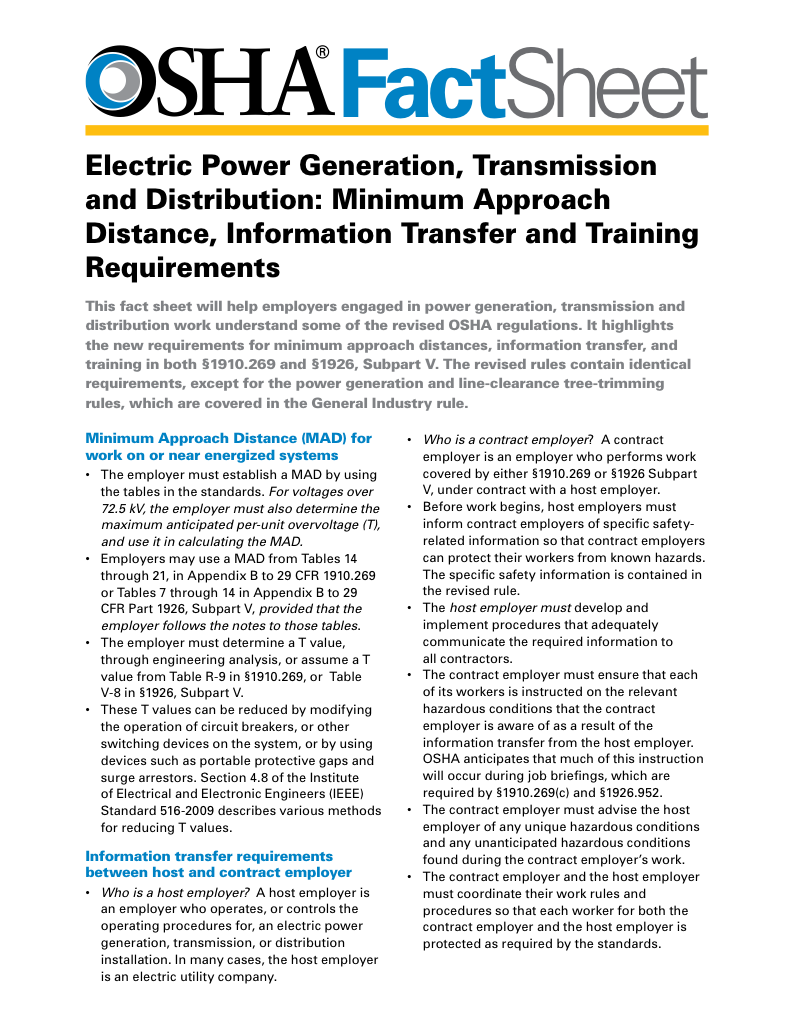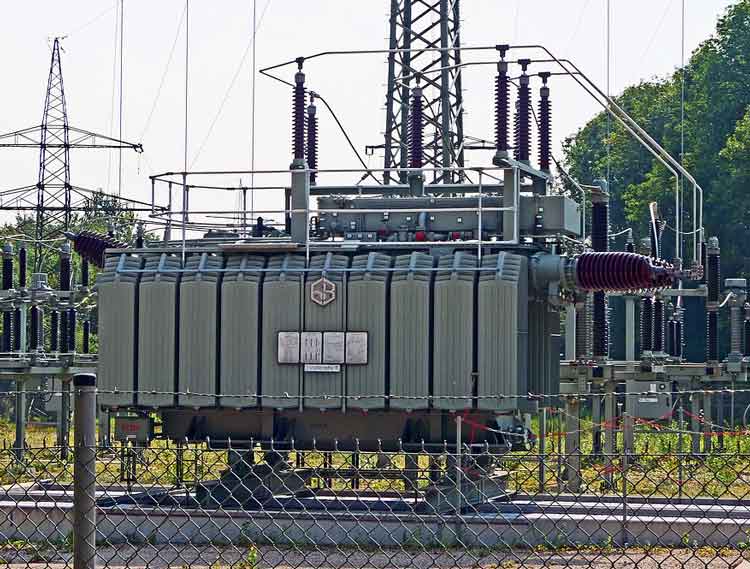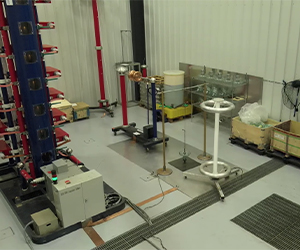When Developing an Electrical Safety Program
NFPA 70e Training
Our customized live online or in‑person group training can be delivered to your staff at your location.

- Live Online
- 6 hours Instructor-led
- Group Training Available
Download Our OSHA 3873 Fact Sheet – Minimum Approach Distance and Training Requirements

- Calculate MAD using voltage and overvoltage values
- Ensure proper communication between host and contract employers
- Meet OSHA training requirements for qualified electrical workers
When developing an electrical safety program, employers must identify hazards, comply with NFPA 70E standards, and train employees effectively. A strong safety program reduces arc flash risks, improves compliance, and protects workers from electrical shock and injury.
What is: "when developing an electrical safety program"
When developing an electrical safety program, consider these essential components:
✅ Identify and assess all electrical hazards, including arc flash and shock risks
✅ Align your program with NFPA 70E and OSHA electrical safety standards
✅ Implement employee training and PPE requirements to ensure workplace safety
When developing an electrical safety program, many organizations either lack a fully developed Program or operate with one that falls short of compliance requirements. To address this gap, the Electricity Forum has developed a new one-day course on Electrical Safety Program Development — a critical resource for EHS Managers, Electrical Supervisors, Safety Managers, and Specialists. This new course complements our established training for Electrical Safety Training for EHS Managers and Supervisors, providing the tools necessary to build, manage, and maintain a world-class program.
Electrical Safety Program Development Course
Electrical Safety Training for EHS Managers and Supervisors
An effective Electrical Safety Program is not a one-time document or a box to check for compliance. It's a living system that protects employees, preserves equipment, and promotes a productive workplace culture. Whether you're building a program from scratch or revitalizing an aging system, there are clear principles to guide your efforts.
When developing an electrical safety program, it is crucial to safeguard workers against the risks of electric shock and other electrical hazards. Such a program must address the design, operation, and maintenance of electrical systems to ensure that all electrical work is performed safely and in compliance with recognized standards. Central to any workplace electrical safety program is the implementation of electrically safe work procedures, including lockout/tagout processes, hazard identification, and energized work permits. A strong emphasis on mitigating electrical hazard risks through training, inspections, and engineering controls helps create a safe work condition for employees who interact with energized equipment or perform live electrical maintenance tasks.
Sign Up for Electricity Forum’s Arc Flash Newsletter
Stay informed with our FREE Arc Flash Newsletter — get the latest news, breakthrough technologies, and expert insights, delivered straight to your inbox.
Who is Responsible for Electrical Safety Program Development?
Responsibility for an Electrical Safety Program lies squarely with management. EHS Managers, Electrical Supervisors, and Safety Specialists must take the lead in designing, implementing, and maintaining these programs. However, ownership doesn't end there. Supervisors, department heads, and ultimately executive leadership must actively support and uphold the program’s principles. Safety cannot be delegated entirely to one department — it must be integrated across the organization.
To align with best practices, organizations should build their programs around the NFPA 70E Standard for Electrical Safety in the Workplace, which provides comprehensive guidance for identifying, evaluating, and controlling the risks associated with electrical activities. The national fire protection standards outlined in NFPA 70E encourage the use of safe work practices designed to protect personnel from arc flash, arc blast, and electric shock incidents. A successful electrical safety program must not only promote technical competence but also foster a culture of safety awareness. From assessing electrical systems during audits to verifying the establishment of a safe work condition, every step reinforces the commitment to workplace safety and helps prevent serious injuries and costly downtime.
What Should an Electrical Safety Program Contain?
A well-structured Electrical Safety Program must include:
-
Compliance with NFPA 70E and CSA Z462 standards for safety in the workplace.
-
Alignment with OSHA regulations on hazardous energy control and general safety.
-
Written procedures for energized work, risk assessments, and job planning.
-
Definitions and clear distinctions between Qualified and Unqualified workers.
-
Lockout/Tagout (LOTO) procedures and training tailored for Authorized and Affected employees.
-
Personal Protective Equipment (PPE) requirements, including the development of a PPE Program.
-
Contractor qualification and management standards, ensuring third-party workers are held to the same safety expectations.
-
Ongoing employee training programs and retraining schedules.
-
Documentation of incidents, near-misses, and corrective actions.
-
Periodic audits, inspections, and program reviews.
A robust program is not static — it must evolve with new technology, changes in work practices, and regulatory updates.
How is an Electrical Safety Program Managed and Updated?
A common pitfall is developing a program, then neglecting to maintain it. Over time, complacency creeps in. Procedures are forgotten, documents become outdated, and the organization's risk tolerance quietly grows. Management must recognize that maintaining a program is an active, continuous process.
Periodic inspections and annual audits are essential to:
-
Verify that written procedures are accurate and effective.
-
Ensure that all employees, especially those performing hazardous tasks, understand and apply proper procedures.
-
Identify gaps in training, equipment, or documentation.
-
Retrain employees as necessary to maintain high performance and safety standards.
Maintenance strategies should extend beyond compliance, incorporating equipment lists and criticality assessments. Organizations that genuinely value safety, rather than treat it as a regulatory obligation, proactively test equipment, refresh procedures, and invest in continuous improvement.
Creating a Culture of Safety: Beyond Compliance
The true success of any program depends on the organizational culture surrounding it.
Is safety a value or merely an obligation?
When safety is a core value, it is evident at every level — from the first-line supervisor to the CEO. Work and safety are not separate concepts; they are fused. Promotions, disciplinary actions, and daily practices reflect an unwavering commitment to employee well-being.
NFPA 70E Training is not about minimal compliance but about building competency and confidence. Communication is frequent, honest, and reinforced with action. Safety leadership is revealed in how problems are surfaced and addressed, rather than being hidden.
Organizations that foster a strong safety culture enjoy measurable benefits, including lower turnover, reduced absenteeism, higher morale, and increased productivity. According to the U.S. Department of Labor, every $1 invested in safety yields a return of $4 to $6. Safety isn't just the right thing to do — it’s good business.
Test Your Knowledge About Arc Flash!
Think you know Arc Flash? Take our quick, interactive quiz and test your knowledge in minutes.
- Instantly see your results and score
- Identify strengths and areas for improvement
- Challenge yourself on real-world electrical topics
Introducing Our New Training Opportunities
To meet the needs of modern EHS leaders and safety professionals, The Electricity Forum has developed two new specialized training opportunities:
-
Electrical Safety Program Development Course: A one-day, six-hour intensive designed specifically for developing, managing, and maintaining Electrical Safety Programs.
-
Electrical Safety Training for EHS Managers and Supervisors: A comprehensive course focused on leadership, risk management, program development, documentation, and contractor oversight.
Both courses are built on decades of expertise. They are designed to empower safety leaders to create programs that not only meet compliance requirements but also foster a true culture of safety excellence.
Request a free safety training quotation to get started or explore our course catalog for more information on how to strengthen your electrical safety program.
Related Articles:








